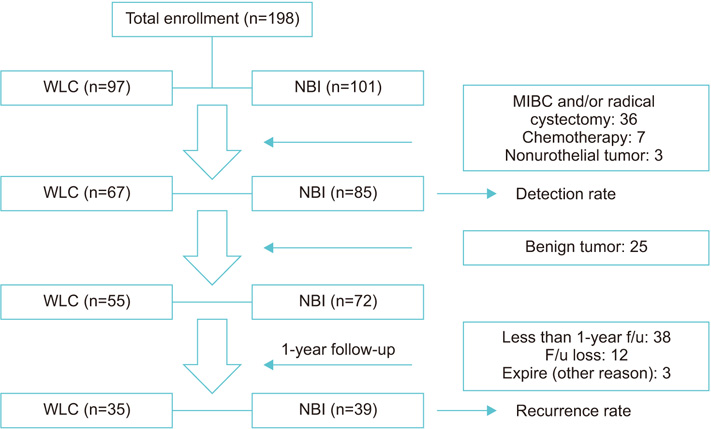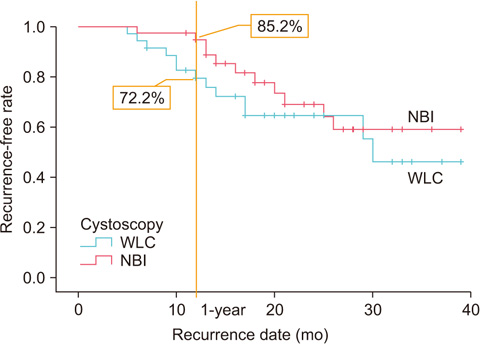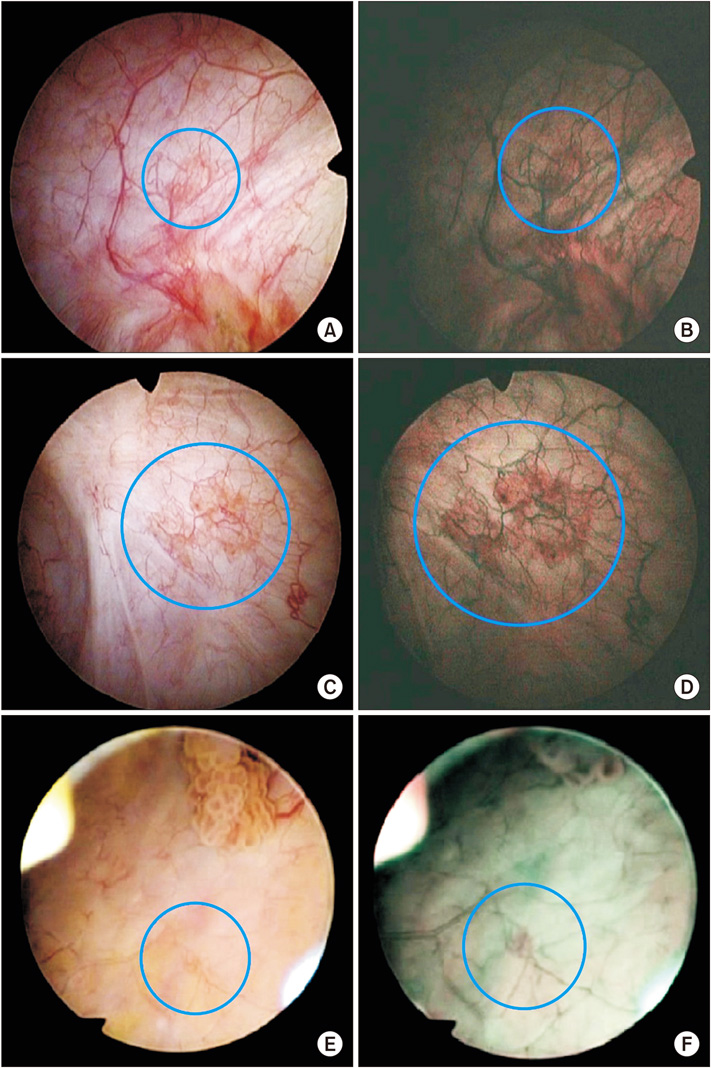Investig Clin Urol.
2018 Mar;59(2):98-105. 10.4111/icu.2018.59.2.98.
Detection and recurrence rate of transurethral resection of bladder tumors by narrow-band imaging: Prospective, randomized comparison with white light cystoscopy
- Affiliations
-
- 1Department of Urology, Korea University College of Medicine, Seoul, Korea. mdksh@korea.ac.kr
- KMID: 2404978
- DOI: http://doi.org/10.4111/icu.2018.59.2.98
Abstract
- PURPOSE
The purpose of this study was to evaluate the efficacy of narrow-band imaging (NBI) as a diagnostic tool for detecting bladder tumors during cystoscopy compared with white light cystoscopy (WLC).
MATERIALS AND METHODS
From December 2013 to June 2017, a randomized prospective study was conducted on 198 patients underwent transurethral resection of bladder tumor by a single surgeon. The patients were divided into two groups according to diagnostic method. In Group I, WLC only was performed. In Group II, NBI was additionally performed after WLC. We analyzed the rate of detection of bladder tumors as a primary endpoint. In addition, we evaluated rates of recurrence in each group.
RESULTS
There were no significant differences between the two groups in characteristics except hypertension. In the analysis of rates of detection, the probability of diagnosing cancer was 80.9% (114/141) in the WLC group, and the probability of diagnosing cancer using WLC in the NBI group was 85.5% (159/186). After switching from WLC to NBI for second-look cystoscopy in the NBI group, NBI was shown to detect additional tumors with a detection rate of 35.1% (13/37) from the perspective of the patients and 42.2% (27/64) from the perspective of the tumors. The 1-year recurrence-free rate was 72.2% in the WLC group and 85.2% in the NBI group (p=0.3).
CONCLUSIONS
NBI had benefits for detecting tumors overlooked by WLC. Although the difference in the 1-year recurrence-free rate was not statistically significant, our results showed a trend for higher recurrence in the NBI group.
MeSH Terms
Figure
Reference
-
1. Woldu SL, Bagrodia A, Lotan Y. Guideline of guidelines: nonmuscle-invasive bladder cancer. BJU Int. 2017; 119:371–380.
Article2. Joung JY, Lim J, Oh CM, Jung KW, Cho H, Kim SH, et al. Current trends in the incidence and survival rate of urological cancers in Korea. Cancer Res Treat. 2017; 49:607–615.
Article3. Lapini A, Minervini A, Masala A, Schips L, Pycha A, Cindolo L, et al. A comparison of hexaminolevulinate (Hexvix(®)) fluorescence cystoscopy and white-light cystoscopy for detection of bladder cancer: results of the HeRo observational study. Surg Endosc. 2012; 26:3634–3641.
Article4. Zlatev DV, Altobelli E, Liao JC. Advances in imaging technologies in the evaluation of high-grade bladder cancer. Urol Clin North Am. 2015; 42:147–157.
Article5. Sylvester RJ, van der, Oosterlinck W, Witjes JA, Bouffioux C, Denis L, et al. Predicting recurrence and progression in individual patients with stage Ta T1 bladder cancer using EORTC risk tables: a combined analysis of 2596 patients from seven EORTC trials. Eur Urol. 2006; 49:466–475.
Article6. Sievert KD, Amend B, Nagele U, Schilling D, Bedke J, Horstmann M, et al. Economic aspects of bladder cancer: what are the benefits and costs. World J Urol. 2009; 27:295–300.
Article7. Bryan RT, Shah ZH, Collins SI, Wallace DM. Narrow-band imaging flexible cystoscopy: a new user's experience. J Endourol. 2010; 24:1339–1343.
Article8. Hewett DG, Kaltenbach T, Sano Y, Tanaka S, Saunders BP, Ponchon T, et al. Validation of a simple classification system for endoscopic diagnosis of small colorectal polyps using narrowband imaging. Gastroenterology. 2012; 143:599–607.
Article9. Bryan RT, Billingham LJ, Wallace DM. Narrow-band imaging flexible cystoscopy in the detection of recurrent urothelial cancer of the bladder. BJU Int. 2008; 101:702–705.
Article10. Li K, Lin T, Fan X, Duan Y, Huang J. Diagnosis of narrow-band imaging in non-muscle-invasive bladder cancer: a systematic review and meta-analysis. Int J Urol. 2013; 20:602–609.
Article11. Kang W, Cui Z, Chen Q, Zhang D, Zhang H, Jin X. Narrow band imaging-assisted transurethral resection reduces the recurrence risk of non-muscle invasive bladder cancer: a systematic review and meta-analysis. Oncotarget. 2017; 8:23880–23890.
Article12. Xiong Y, Li J, Ma S, Ge J, Zhou L, Li D, et al. A meta-analysis of narrow band imaging for the diagnosis and therapeutic outcome of non-muscle invasive bladder cancer. PLoS One. 2017; 12:e0170819.
Article13. Naito S, Algaba F, Babjuk M, Bryan RT, Sun YH, Valiquette L, et al. The Clinical Research Office of the Endourological Society (CROES) multicentre randomised trial of narrow band imaging-assisted Transurethral Resection of Bladder Tumour (TURBT) versus conventional white light imaging-assisted TURBT in primary non-muscle-invasive bladder cancer patients: trial protocol and 1-year results. Eur Urol. 2016; 70:506–515.
Article14. Cauberg EC, Kloen S, Visser M, de la Rosette JJ, Babjuk M, Soukup V, et al. Narrow band imaging cystoscopy improves the detection of non-muscle-invasive bladder cancer. Urology. 2010; 76:658–663.
Article15. Shen YJ, Zhu YP, Ye DW, Yao XD, Zhang SL, Dai B, et al. Narrow-band imaging flexible cystoscopy in the detection of primary non-muscle invasive bladder cancer: a "second look" matters. Int Urol Nephrol. 2012; 44:451–457.
Article16. Chen G, Wang B, Li H, Ma X, Shi T, Zhang X. Applying narrow-band imaging in complement with white-light imaging cystoscopy in the detection of urothelial carcinoma of the bladder. Urol Oncol. 2013; 31:475–479.
Article17. Naselli A, Introini C, Timossi L, Spina B, Fontana V, Pezzi R, et al. A randomized prospective trial to assess the impact of transurethral resection in narrow band imaging modality on non-muscle-invasive bladder cancer recurrence. Eur Urol. 2012; 61:908–913.
Article18. Kobatake K, Mita K, Ohara S, Kato M. Advantage of transurethral resection with narrow band imaging for non-muscle invasive bladder cancer. Oncol Lett. 2015; 10:1097–1102.
Article19. Geavlete B, Multescu R, Georgescu D, Stanescu F, Jecu M, Geavlete P. Narrow band imaging cystoscopy and bipolar plasma vaporization for large nonmuscle-invasive bladder tumors--results of a prospective, randomized comparison to the standard approach. Urology. 2012; 79:846–851.
Article20. Ma T, Wang W, Jiang Z, Shao G, Guo L, Li J, et al. Narrow band imaging-assisted holmium laser resection reduced the recurrence rate of non-muscle invasive bladder cancer: a prospective, randomized controlled study. Zhonghua Yi Xue Za Zhi. 2015; 95:3032–3035.21. Stănescu F, Geavlete B, Georgescu D, Jecu M, Moldoveanu C, Adou L, et al. NBI - plasma vaporization hybrid approach in bladder cancer endoscopic management. J Med Life. 2014; 7:155–159.22. Song PH, Cho S, Ko YH. Decision based on narrow band imaging cystoscopy without a referential normal standard rather increases unnecessary biopsy in detection of recurrent bladder urothelial carcinoma early after intravesical instillation. Cancer Res Treat. 2016; 48:273–280.
Article23. Drejer D, Béji S, Munk Nielsen A, Høyer S, Wrist Lam G, Jensen JB. Clinical relevance of narrow-band imaging in flexible cystoscopy: the DaBlaCa-7 study. Scand J Urol. 2017; 51:120–123.
Article24. Naselli A, Introini C, Bertolotto F, Spina B, Puppo P. Feasibility of transurethral resection of bladder lesion performed entirely by means of narrow-band imaging. J Endourol. 2010; 24:1131–1134.
Article25. Jancke G, Rosell J, Jahnson S. Impact of surgical experience on recurrence and progression after transurethral resection of bladder tumour in non-muscle-invasive bladder cancer. Scand J Urol. 2014; 48:276–283.
Article
- Full Text Links
- Actions
-
Cited
- CITED
-
- Close
- Share
- Similar articles
-
- Postoperative Recurrent Bladder Tumors Detection by Narrow-Band Imaging Cystoscopy
- Efficacy and Safety of Hexaminolevulinate Fluorescence Cystoscopy in the Diagnosis of Bladder Cancer
- The Significance of Simultaneous Transurethral Resection of Bladder Tumor and the Prostate in Patient who have Superficial Bladder Cancer with Bladder Outlet Obstruction
- Decision Based on Narrow Band Imaging Cystoscopy without a Referential Normal Standard Rather Increases Unnecessary Biopsy in Detection of Recurrent Bladder Urothelial Carcinoma Early after Intravesical Instillation
- Postoperative Recurrent Bladder Tumors Detection by Narrow-Band Imaging Cystoscopy




